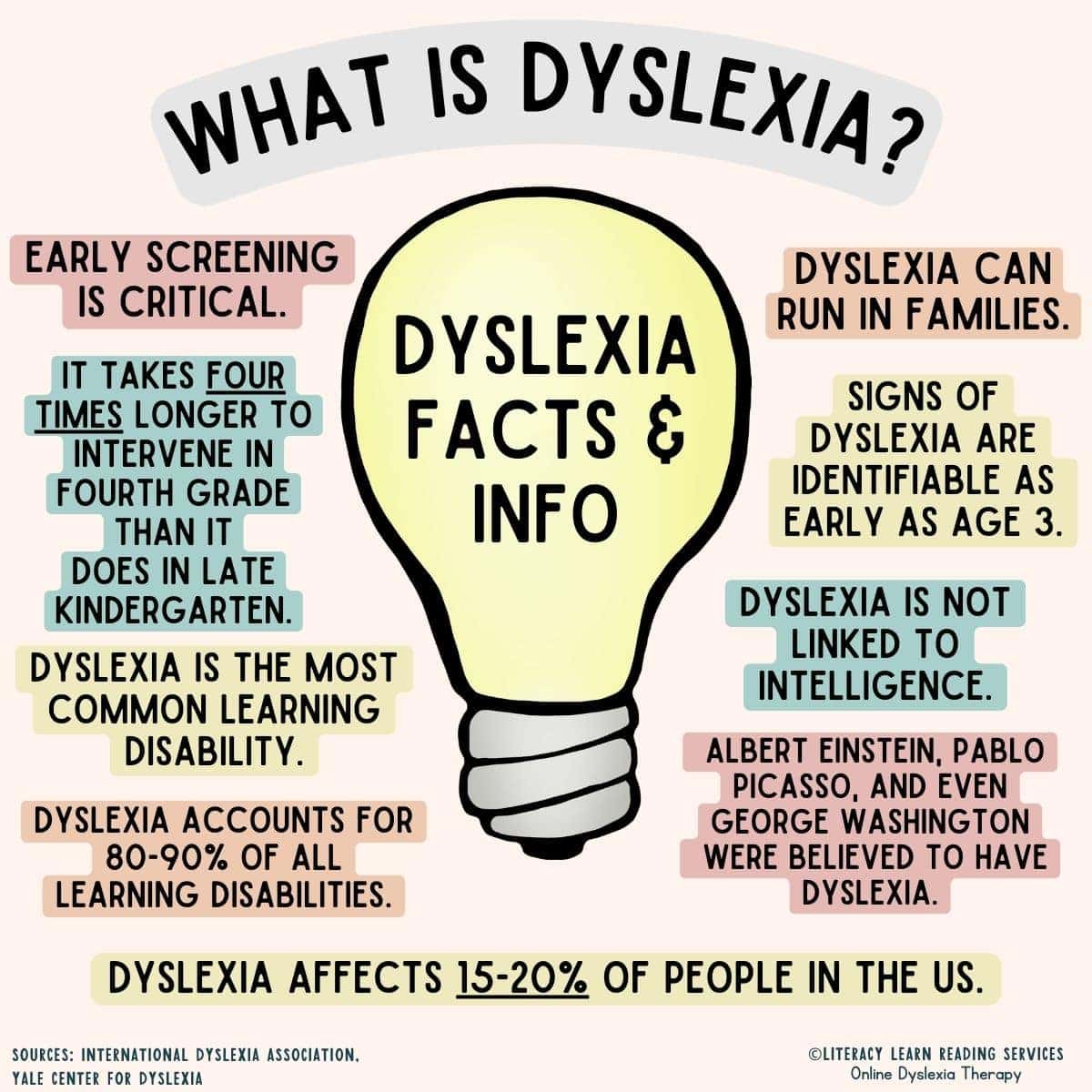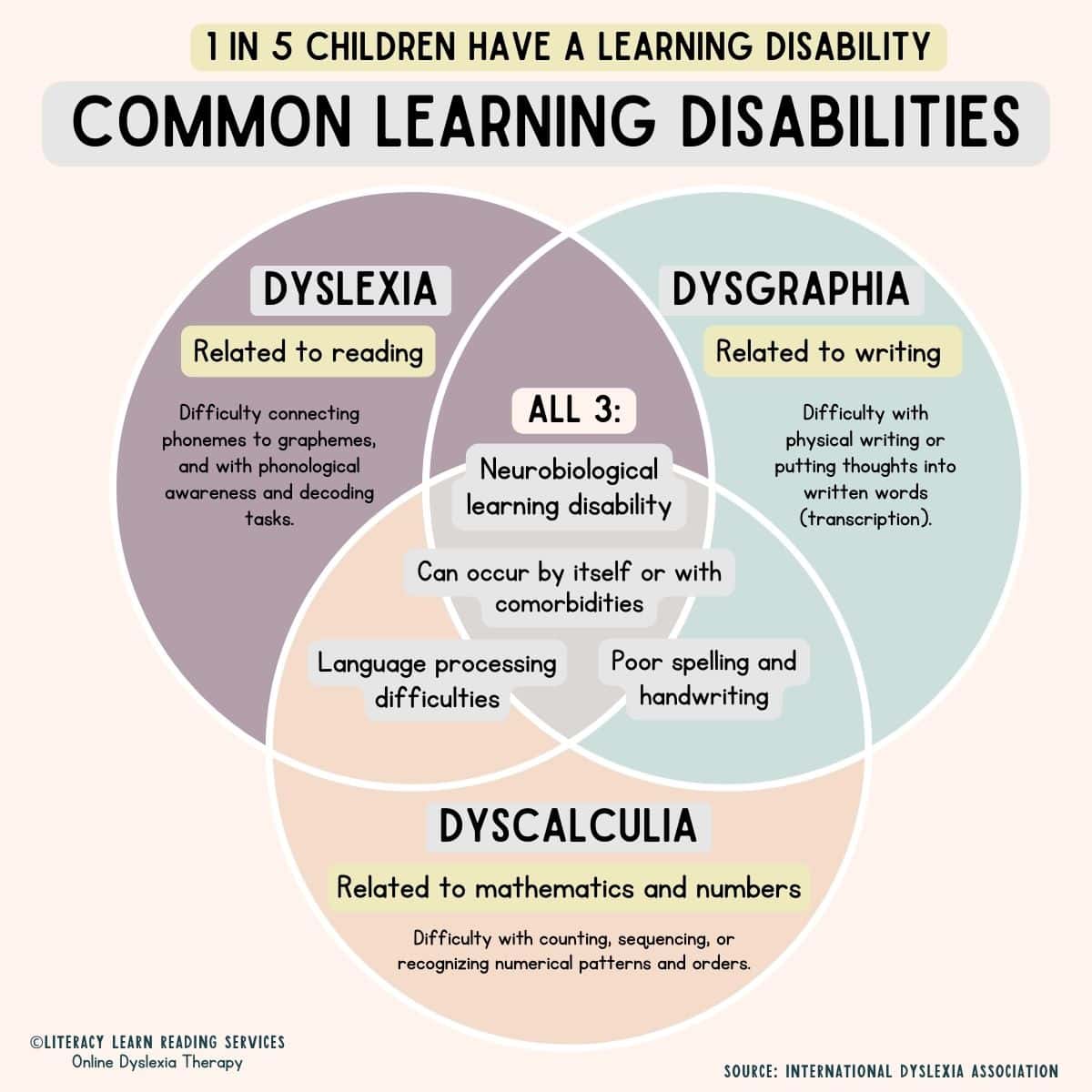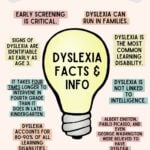Dyslexia: Characteristics, Definitions & Resources
This post may contain affiliate links. As an Amazon affiliate, we earn from qualifying purchases.
You’ve probably heard the term before, but exactly what is dyslexia? As part of our dyslexia info series, we’re sharing definitions, characteristics, research, and resources for parents and teachers of struggling readers.

This post is sponsored by Lexercise. All opinions are our own.
📚 Take a FREE Dyslexia Screener and learn more about Dyslexia Therapy options for struggling readers and writers!
What Is Dyslexia?
Dyslexia Definition
Dyslexia is a learning disability that refers to a “cluster of symptoms” that negatively affect a person’s ability to read, write, spell, and process language.
The International Dyslexia Association (IDA) explains, “Dyslexia is a specific learning disability that is neurological in origin. It is characterized by difficulties with accurate and/or fluent word recognition and by poor spelling and decoding abilities.”
Causes of Dyslexia
We don’t know all the reasons why dyslexia occurs, but scans of the brain (fMRIs) show that the dyslexic brain works differently from the non-dyslexic brain.
Dr. Sally Shaywitz (2020) calls this the “neural signature for dyslexia” – meaning that connections of the reading systems in the back portion of the brain don’t function efficiently.
This makes it harder for people with dyslexia to break down written language and transcribe letters into sounds, which is essential for reading.
Key Characteristics of Dyslexia
The symptoms and severity of dyslexia vary from person to person. It occurs on a continuum, meaning it can be mild, moderate, or severe.
In general, people with dyslexia tend to have trouble with spoken language, recognizing word sounds (phonemes), letter-knowledge, phonemic awareness, making sound-symbol connections, decoding words, spelling words, and slow reading.
How Common Is Dyslexia?
Dyslexia is much more common than you might imagine!
According to the IDA, it’s estimated that dyslexia may affect up to 20% of the population. It’s the most common learning disability, accounting for 80% of all those with specific learning disabilities.
Based on these numbers, along with recent statistics for children receiving special education services in US public schools, we can infer that about 2 million children are receiving special education services for dyslexia.
But this number reflects only the kids who have been through a full diagnostic assessment and have been found eligible.
We know millions of kids have yet to be screened, assessed, or officially tested; these are the kids who are sitting in our classrooms, struggling, failing, and desperate for help.
👉 Did you know? Dyslexia is also known to run in families, so having a parent with dyslexia is a risk factor. In fact, a study done by Snowling and Melby-Lervag (2016) found that if a parent had dyslexia, their child would have a 45% chance of having a reading disorder.
But it’s important to note that at this time, there is no genetic factor that can be tested to identify dyslexia. You can, however, get a free dyslexia screener and learn more about your child’s individual needs.

Dyslexia, Dysgraphia, and Dyscalculia
Dyslexia, dysgraphia, and dyscalculia are often confused with each other, and for good reason! They are all neurological disorders, and there’s definitely some overlap in how they present.
That said, they are separate and distinct disabilities, and recognizing how they differ is really important for teachers and parents because it helps us know how to support and advocate for kids!
All three (dyslexia, dysgraphia, and dyscalculia) are neurobiological. They can occur alone, together, or with other learning disabilities or disorders like ADHD.
All three are characterized by language processing problems like working memory, processing speed, and verbal comprehension. They all involve incomplete automaticity for foundational, basic skills.
📖 Dyslexia
Dyslexia is related to problems with reading and language processing. It makes decoding words and understanding the meaning of words difficult, which means people with dyslexia have trouble reading text and spelling. If you have concerns, you can assess your child for dyslexia.
📝 Dysgraphia
Dysgraphia is related to problems with writing. It has to do with orthographic coding, which is “the ability to store written words in working memory while the letters in the word are analyzed,” according to IDA.
The hallmarks of dysgraphia are poor handwriting, poor spelling, and difficulty organizing ideas in writing. If this sounds like your child, get a free dysgraphia test to learn more.
🔢 Dyscalculia
Dyscalculia is related to problems with the brain processes numbers and number relationships. Research indicates that high rates of comorbidity have been reported for dyslexia and dyscalculia, anywhere from 17-60%.*
Best Practices for Teachers
Research gives us lots of insight into how we can better help students with reading and writing difficulties.
- Early Screening and Assessment: The earlier we can identify a child with dyslexia, the earlier the child can receive help with interventions. It is important to intervene as early as possible, because the brain changes with age. It takes four times longer to intervene in fourth grade than it does in late kindergarten!!
- Structured Literacy Intervention: The International Dyslexia Association says that Structured Literacy is “the most effective approach for students who experience unusual difficulty learning to read and spell printed words.” (And this is the best type of instruction for ALL readers, whether they have a disability or not.)
- Multimodal Learning: Engaging multiple learning modalities (auditory, visual, tactile/kinesthetic) during learning helps build brain connections and support reading skills!
- Specific and Measurable Goals: Specific goals should be set based on current baseline data. Having goals will ensure that the child is receiving targeted instruction and ensure that progress is being made.
- Accommodations: Accommodations can help students to thrive and reduce anxiety in academic situations. Schools may allow a student to have extra time to complete tasks or provide audiobooks and other assistive technology or tools.
- Positive Reinforcement: Remember to encourage the effort as well as the outcome. You can help build a student’s confidence by encouraging them and celebrating small victories.
- Research-backed curriculum: A structured literacy curriculum is critical for students. Check out Lexercise for Schools for a program that actually works!
Resources & Expert Help for Parents
If you’re a parent of a child struggling with reading and writing, we understand how overwhelming it can be to find the right support.
Schools don’t always provide the help your child needs, leaving you unsure of where to turn. But don’t worry, we’re here to guide you.
Our friends at Lexercise offer professional, research-based therapy that’s expertly tailored to meet your child’s unique learning needs.
- Take a free dyslexia screener. The results can be a great starting point and help you decide if further assessment or treatment would be useful for your child.
- Get a professional assessment of your child’s grade level in reading, writing, and spelling, including a personalized written report to guide your child’s journey to success.
- Schedule a consult to learn more about dyslexia therapy, where your child is guaranteed to make progress (or therapy is free).

Helpful Resources
Books We Recommend
- Essentials of Assessing, Preventing, and Overcoming Reading Difficulties by David Kilpatrick
- Shifting the Balance: 6 Ways to Bring the Science of Reading into the Balanced Literacy Classroom by Jan Burkina
- The Gillingham Manual: Remedial Training for Students With Specific Disability in Reading, Spelling, and Penmanship by Anna Gillingham
- Overcoming Dyslexia by Dr. Sally Shaywitz
International Dyslexia Association Articles
- Dyslexia and the Brain
- What is Dysgraphia?
- ADHD and Dyslexia
- KPS for Teachers
- What is Dyslexia (video)
Yale Center for Dyslexia
- Overcoming Dyslexia e-Course: This is a FREE course from Yale with modules covering all topics related to Dyslexia.
- Dyslexia FAQ
- Developing a Foundation for Reading
National Institutes of Health Articles
- Decoding Dyslexia: Helping Kids Who Struggle With Reading
- Dr. Jack Fletcher on Dyslexia
- Language, Reading, and Math Profiles in School Children*
Unlocking Dyslexia (NPR Series)
👇 Be sure to check out the other installments of the Dyslexia Information series:
- Debunking Common Dyslexia Myths
- Understanding Dyslexia Symptoms
- How Structured Literacy Helps Struggling Readers
We hope this information has been helpful for you! If you have any questions or concerns, please leave a comment and let us know!

